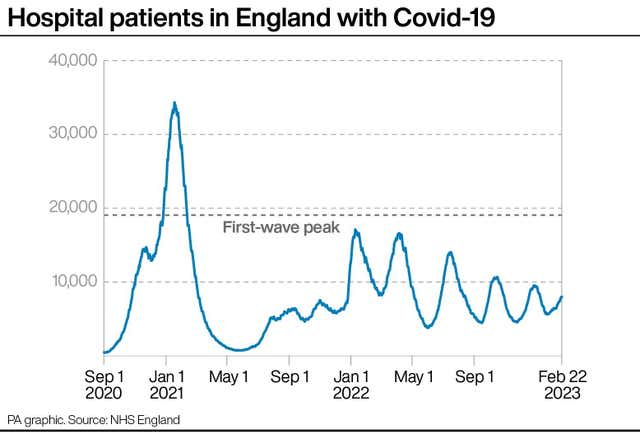UK Covid-19 infections rise for third week in a row
Total Covid-19 infections in the UK have jumped for the third week in a row, as most parts of the country continue to see a rise in prevalence of the virus.
Levels have increased among all adults over 25 in England, though the proportion of schoolchildren testing positive has fallen.
An estimated 1.4 million people in private households in the UK were likely to have Covid-19 in the week to February 14, up 17% from 1.2 million the previous week, according to the Office for National Statistics (ONS).
This is the highest total since early January.

A surge in the virus in the run-up to Christmas saw infections peak just below three million at the end of December.
The figure then fell for much of January, before rising again in recent weeks.
The current increase is being driven by the Omicron variant BA.2.75, which has overtaken BA.5 and its subvariants as the dominant type of coronavirus in the UK, the ONS said.
The BA.5 variant had been responsible for most Covid-19 infections in the country since the end of June 2022.
But nearly three-quarters (74.5%) of sequenced infections now belong to the BA.2.75 family, including its subvariants XBB and CH.1.1, both of which have a “growth advantage”, according to the UK Health Security Agency (UKHSA).
Michelle Bowen, ONS head of health surveillance, said: “Infections have continued to increase across most of the UK, with Northern Ireland the exception with an uncertain trend in the most recent week.
“Across age groups in England the picture is mixed. We’ve seen decreases in schoolchildren, though this data comes too early to see the impact of half-term, yet growth in all adults over the age of 25.”
The latest data from our #COVID19 Infection Survey show infections:
▪️ continued to increase in England, Wales and Scotland▪️ The trend was uncertain in Northern Ireland
➡️ https://t.co/XglddT9V54 pic.twitter.com/q38OwOShyG
— Office for National Statistics (ONS) (@ONS) February 24, 2023
Around one in 45 people in England is estimated to have coronavirus, up from one in 55 the previous week.
The virus continues to be least prevalent in Northern Ireland, at around one in 60 people.
The latest estimate for Scotland is one in 45 people, while for Wales it is one in 55.
Around 2.7% of children in England between school Year 7 and 11 were likely to test positive for Covid-19 in the latest week, the highest percentage for any age group, though the figure is down from 3.1% the previous week.
The next highest rate is for 3 to 49-year-olds, at 2.6%, up from 2.3%.
Across the regions of England, infections have increased in the North East, North West, East Midlands, London and the South West, while the trends elsewhere were uncertain.
The ONS infection survey is the most reliable measure of the prevalence of coronavirus and is based on a sample of swab tests from households across the country.

Of all the waves of Covid-19 to hit the UK since the survey began in summer 2020, the spring 2022 wave – driven by the Omicron BA.2 variant – is estimated to have sent infections to their highest weekly total on record, at 4.9 million.
The winter 2021/22 wave, caused by the original Omicron variant, saw infections peak at 4.3 million, while the summer 2022 wave, driven by Omicron variants BA.4 and BA.5, led to a high of 3.7 million.
Separate NHS data shows the rate of Covid-19 hospital admissions in England has climbed to its highest level since the start of the year.
There were 9.4 admissions per 100,000 people in the week to February 19, up from 7.9 per 100,000 the previous week and the fourth successive increase.
The rate peaked at 11.8 per 100,000 over Christmas 2022.
A total of 8,015 people were in hospital in England on February 22 who had tested positive for Covid-19, up 11% on the previous week and the highest since January 10.
The number reached 9,535 on December 29 – though this was well below levels seen in early waves of the pandemic.
Dr Mary Ramsay, UKHSA head of immunisation, said: “Hospital admission rates for Covid-19 are continuing to increase, particularly among those aged 65 and over.
“You can help by regularly washing your hands or staying at home and avoiding vulnerable people if you are unwell.
“If you do have to leave the house, please consider wearing a face covering, which can help prevent you passing respiratory viruses on.”


